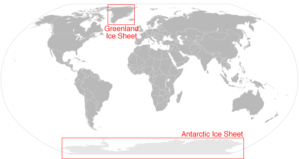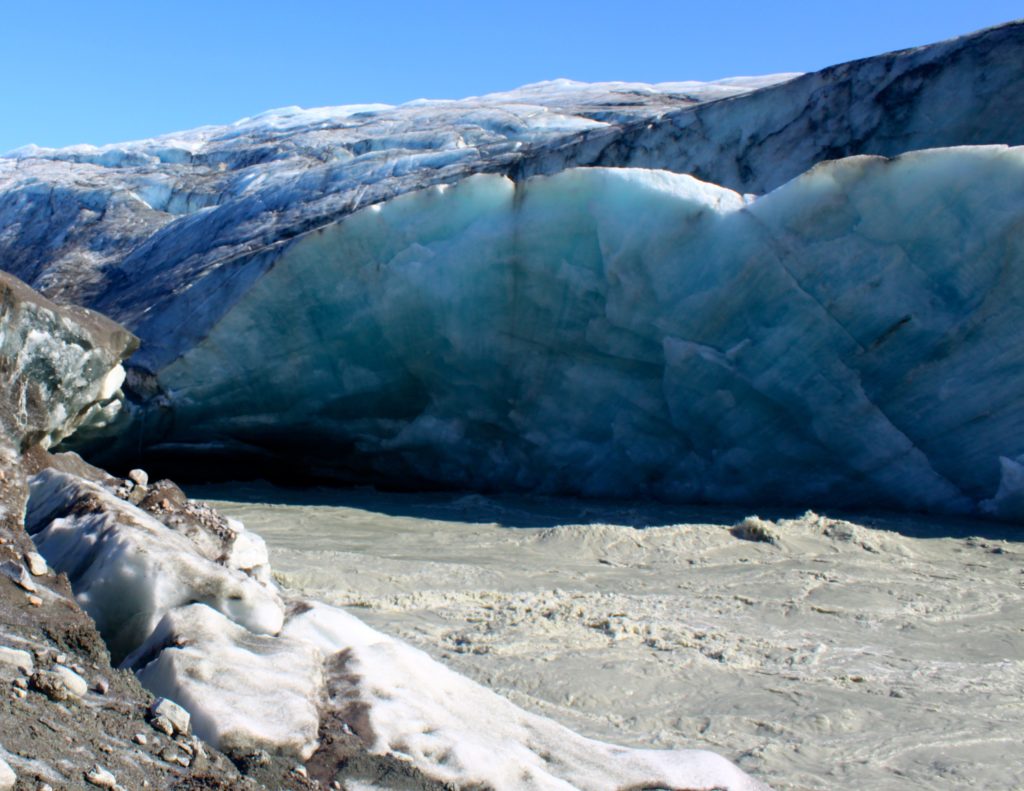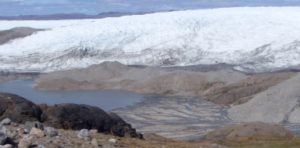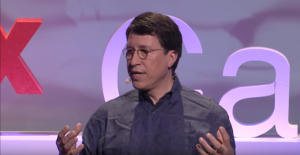Murky Waters: How Sediments Impact Greenland’s Melting Ice Sheets
Image caption: The sediment-rich meltwater river originating from Leverett Glacier in southwest Greenland, pictured in June 2012. Photo credit: Jon Hawkings
Few consequences of global climate change are as notorious as melting ice sheets. However, the process responsible for this phenomenon is not as straightforward, or as well-understood, as might be imagined.

Together, the Greenland and Antarctic Ice Sheets contain more than 99 percent of the freshwater ice on Earth. Credit: NSIDC
Ice sheets are masses of glacial ice that form over land, covering a minimum of 50,000 square kilometers (20,000 square miles) [1]. During Earth’s most recent ice ages, ice sheets stretching into the Arctic Ocean blanketed much of the northern regions of North America and Europe, while Antarctica’s land mass was buried beneath ice sheets that extended as deep into the ocean as the continental shelf [2].
Today, most of the Earth has emerged from beneath the ice, but Greenland’s ice sheets still span approximately 1.7 million square kilometers (656,000 square miles), covering the majority of the island’s surface – an expanse three times as large as Texas. Together with Antarctica’s ice sheets, which cover 14 million square kilometers (5.4 million square miles), they account for 99% of Earth’s freshwater ice. Were Greenland’s ice sheets to melt, global sea level would rise 6 meters (20 feet) [1].
In addition to serving as valuable freshwater reserves, ice sheets have a major influence on global climate and weather patterns, their expansive plateaus capable of changing the paths of storms and causing wind to blow downslope along the ice’s surface [1]. The ice consists of a mixture of water molecules, dust, and gases, the composition of which contains valuable information about the history of the Earth’s climate, which scientists can study by removing ice cores for analysis [1].
A 2017 study published in Nature examined the role of freshwater runoff in delivering sediments from Greenland’s sizable ice sheets to the surrounding ocean. Fluvial delivery is the main mechanism by which materials move on the surface of the Earth, and they’re responsible for the transport of over 56% of sediment that enters the ocean, impacting everything from the dynamics of coastal zones to ocean biogeochemistry to marine ecosystems [3].
Using satellite imagery, researchers gauged the concentration of suspended sediment in 160 proglacial rivers across Greenland. In doing so, they determined that while Greenland contributes approximately 1.1% of the total freshwater runoff gained by the ocean, it also contributes 8% of the ocean’s fluvial delivery of suspended sediments, an amount the study’s authors termed “disproportionately large” [3]. From their observations, they were also able to infer that sediment flux levels have increased 56% since the 1961-2000 period. While the researchers were hesitant to conjecture about the potential impacts of elevated levels of fine sediment entering the ocean, they pointed out that higher volumes of fine sediment are often accompanied by labile nutrients like iron, and noted the possibility of an increase in phytoplankton blooms in the waters surrounding Greenland. However, much debate remains about the biogeochemistry of Greenland’s fjords and coastal zones, including whether or not they function as a carbon sink [3].
Other studies focused on Greenland’s ice sheets have generated further interesting findings. A 2021 study published in Geophysical Research Letters found that bacteria are likely accelerating the melting of the region’s ice sheets by concentrating the sediment into larger particles, which form deposits in streambeds. These sediment deposits darken the bottoms of streams, reducing their albedo –– their ability to deflect sunlight –– and therefore contribute to subsequent melting of ice [4]. The study also states that research into glacial sediment distribution is rare, emphasizing the urgent need for further studies.
Melting ice sheets are a major contributor to rising sea levels, which have far-reaching and devastating impacts: stress on coastal ecosystems, erosion, and flooding of regions of high population density, resulting in damage to infrastructure and the displacement of those residing there. But according to geologist and professor Minik Rosing, it doesn’t have to be all bad news. In his TEDxCannes talk in 2016 [5], Rosing laments that the Arctic region has become a symbol of environmental disaster, a characterization he feels is misleading. Instead, he believes that melting ice sheets offer an opportunity. He proposes the establishment of an industry that collects the minerals from Greenland’s freshwater runoff and distributes them in regions of the world with unhealthy, nutrient-poor soil. In particular, he points to tropical regions as places that would particularly benefit from remineralization, which would stimulate agricultural production and thus economic development.
But it’s not just the regions receiving rock dust that he believes will benefit from this new industry – Greenland economy will also benefit, as will its environment, as the nation gains a way to profit from natural resources without causing harm to natural spaces. Rosing goes as far as to calculate that the amount of CO2 pulled from the atmosphere by the remineralized crops would offset the amount of CO2 expended transporting the minerals from the Arctic to the tropics.
Given the harm that rising sea levels have already caused, and the further harm they are predicted to cause in coming years, the need for additional research into the relationship between melting ice sheets and sediments has never been more crucial. Equally crucial are researchers like Rosing, who understand that unprecedented problems require unprecedented solutions. Whether human innovation will prove a match for human devastation has yet to be determined, but developing a cohesive understanding of how ice melt occurs, and what can be done to combat its acceleration, will be integral to humanity’s ability to adapt to the changing climate.
break
Pavi Chance works with the Washington Conservation Corps on a riparian habitat restoration crew. She is a graduate of Barnard College, where she received a BA in English and human rights studies. Growing up in the beautiful Pacific Northwest, she developed an enduring appreciation for the natural world, and seeks to ensure it is protected and preserved for generations to come.
break
References
- Quick Facts on Ice Sheets. (n.d.). National Snow & Ice Data Center. Retrieved October 31, 2021, from https://nsidc.org/cryosphere/quickfacts/icesheets.html
- Carlson, A. E. (2011) Ice Sheets and Sea Level in Earth’s Past. Nature Education Knowledge 3(10): 3. Retrieved October 31, 2021, from https://www.nature.com/scitable/knowledge/library/ice-sheets-and-sea-level-in-earth-24148940/?error=cookies_not_supported&code=1e14172f-87ec-4a7c-bd15-6671d32acf69
- Overeem, I., Hudson, B. D., Syvitski, J. P. M., Mikkelsen, A. B., Hasholt, B., van den Broeke, M. R., Noël, B. P. Y., & Morlighem, M. (2017). Substantial export of suspended sediment to the global oceans from glacial erosion in Greenland. Nature Geoscience, 10(11), 859–863. https://doi.org/10.1038/ngeo3046
- Leidman, S. Z., Rennermalm, S. K., Muthyala, R., Guo, Q., & Overeem, I. (2021). The Presence and Widespread Distribution of Dark Sediment in Greenland Ice Sheet Supraglacial Streams Implies Substantial Impact of Microbial Communities on Sediment Deposition and Albedo. Geophysical Research Letters, 48(1). https://doi.org/10.1029/2020gl088444
- Rosing, M. (2016). Climate Change: what the North can do for the tropics | Minik Rosing | TEDxCannes [Video]. TEDxCannes [TEDx Talks]. https://www.youtube.com/watch?v=PCupHgKGCcY&t=499s
Support us on Patreon
Thank you for joining us today! Please become a member of RTE and support us on Patreon. Unlike many larger organizations, we work with a team of determined and passionate volunteers to get our message out. We aim to continue to increase the awareness of remineralization to initiate projects across the globe that remineralize soils, grow nutrient dense food, regenerate our forests’ and stabilize the climate – with your help! If you can, please support us on a monthly basis from just $2, rest assured that you are making a big impact every single month in support of our mission. Thank you!










Got something to say?